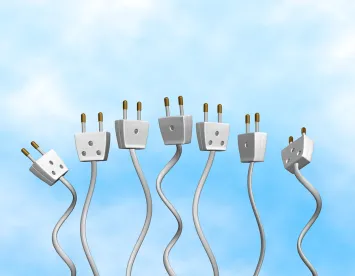FERC claims that the change in the nation’s generation mix and increase in interconnection requests necessitate reforms to improve the efficiency and transparency of the interconnection process.
After 13 years, the Federal Energy Regulatory Commission (FERC) is proposing reforms to its pro forma Large Generator Interconnection Procedures (LGIP) and pro forma Large Generator Interconnection Agreement (LGIA) to enhance the efficiency and transparency of the interconnection process and to increase certainty for interconnection customers by providing more timely and accurate information on a more predictable basis. FERC conducted its last major review of the interconnection process in 2003, which resulted, for the first time, in a standardized interconnection process as set forth in Order No. 2003.
If adopted, each public utility transmission provider will need to submit a compliance filing within 90 days of the effective date of the final rule revising its LGIP and LGIA to meet the requirements in the final rule. Those transmission providers with provisions in their existing LGIPs and LGIAs that FERC previously found to be consistent or superior to the pro forma LGIP and LGIA must either comply with the final rule or demonstrate that the existing LGIPs and LGIAs are consistent with or superior to the pro forma LGIP and LGIA as modified by the final rule.
These proposed reforms could result in generator interconnection processes that are more economically efficient and less likely to result in extended disputes, as well as the ability to transfer unused interconnection capacity to maximize the use of existing facilities.
Background
The Notice of Proposed Rulemaking (NOPR) stems in part from a Petition for Rulemaking that the American Wind Energy Association (AWEA) filed in 2015 and a technical conference that followed in May 2016. AWEA argued that the LGIP and LGIA have become out of date in light of current market conditions and are not able to ensure that the interconnection process is just, reasonable, and not unduly discriminatory or preferential. AWEA proposed reforms that it claimed would improve (1) certainty in the study/restudy process, (2) transparency in the interconnection process, (3) certainty for network upgrade costs, and (4) accountability.
Proposed Reforms to the Interconnection Process
FERC is proposing 14 reforms to improve aspects of the pro forma LGIA and LGIP. These reforms are intended to (1) improve customer certainty in the interconnection process, (2) improve transparency by providing more information to interconnection customers, and (3) enhance interconnection processes.
FERC found that aspects of the current interconnection process can hinder the timely development of new generation, thereby stifling competition in wholesale markets. FERC recognized that the current interconnection process can create uncertainty for interconnection customers with respect to cost and timing, which reduces their ability to obtain project financing. FERC also noted that many interconnection customers have experienced delays in the interconnection process and that interconnection queues have significant backlog. In addition, FERC recognized the increase in emerging technologies and variable energy resources (e.g., wind generation and electric storage resources) and the need to ensure that the interconnection process accounts for the capabilities of these resources.
Reforms to Improve Certainty in the Interconnection Process
FERC is proposing four reforms to afford interconnection customers more predictability in the interconnection process through more timely and accurate information. FERC’s intent is that improving the certainty and quality of information conveyed earlier in the interconnection process will reduce the number of interconnection request withdrawals, which should reduce the number of restudies and queue times.
FERC proposes to do the following:
-
Revise the pro forma LGIP to require transmission providers that conduct cluster studies to move toward a scheduled, periodic restudy period (e.g., annually, semi-annually, quarterly, or a set number of days after the completion of the cluster study, as determined by the transmission provider).
-
Allow interconnection customers to exercise the option to build unilaterally by removing from the pro forma LGIA the limitation that interconnection customers may only exercise the option to build transmission provider’s interconnection facilities and standalone network upgrades if the transmission owner cannot meet the dates proposed by the interconnection customer.
-
Modify the pro forma LGIA to require mutual agreement between the transmission owner and interconnection customer for the transmission owner to elect to initially self-fund the costs of the construction of network upgrades.
-
Require that the Regional Transmission Organizations (RTOs) and Independent System Operators (ISOs) establish dispute resolution procedures for interconnection disputes that allow a disputing party to unilaterally seek dispute resolution in RTO/ISO regions.
FERC seeks comment on the above four reforms and on issues including
-
whether regions that conduct cluster studies and move to periodic restudies should retain some discretion to conduct restudies outside the established schedule;
-
whether FERC should further revise the pro forma LGIP to improve the transparency and application of restudy triggers;
-
whether there are benefits to interconnection customers from forgoing the opportunity to fund network upgrades or from funding the network upgrades themselves; and
-
whether the dispute resolution processes outside of RTO/ISO regions are adequate.
FERC also seeks comment on whether it should add to the pro forma LGIP and LGIA a cost cap that would limit an interconnection customer’s network upgrade costs at the higher bound of a transmission provider’s cost estimate plus a stated accuracy margin following a certain stage of the interconnection process. This could permit the interconnection customer to assume costs that exceed the cap in limited circumstances. FERC seeks comment on how to minimize potential cost shifts to other parties if the cost cap is imposed.
Reforms to Improve Transparency
FERC is proposing five reforms to improve the transparency of information for all participants in the interconnection process.
FERC proposes to do the following:
-
Require transmission providers to detail the method they use to determine contingent facilities in evaluating an interconnection request in their LGIPs and LGIAs based upon guiding principles in the proposed rule (contingent facilities are those unbuilt interconnection facilities and network upgrades upon which the interconnection request’s costs, timing, and study findings are dependent and, if not built, could cause a need for restudies of the interconnection request or a reassessment of network upgrades and/or costs and timing).
-
Require transmission providers to list all network models and underlying assumptions used for interconnection studies in their pro forma LGIPs and on their Open Access Same-Time Information System (OASIS) sites and to include non-confidential supporting data on their OASIS sites.
-
Require transmission providers to post congestion and curtailment information in one location on their OASIS sites.
-
Revise the definition of “Generating Facility” in the pro forma LGIP and LGIA to explicitly include electric storage resources.
-
Require transmission providers to report on their completion of interconnection studies within established timeframes.
FERC is also seeking comment on additional steps that the Commission could take to improve the resolution of issues that arise when affected systems are impacted by a proposed interconnection, as well as on issues including
-
how the process for identifying contingent facilities can be standardized;
-
whether there are other specific network model details and underlying assumptions that transmission providers should post on their OASIS sites and describe in their pro forma LGIPs;
-
whether transmission providers should provide notice of any variation from the posted network model assumptions for a specific study;
-
where congestion and curtailment information should be posted, and the level of granularity of the information posted; and
-
whether interconnection customers have sufficient information on and transparency into the cause of study delays under the current LGIP provisions.
Reforms to Enhance Interconnection Process
FERC is proposing five reforms to enhance interconnection processes by making use of underutilized existing interconnections, providing interconnection service earlier, or accommodating changes in the development process.
FERC proposes to do the following:
-
Allow interconnection customers to limit their requested level of interconnection service below their generating facility capacity, require transmission providers to have a process in place in their pro forma LGIPs and LGIAs to consider such requests, and require an interconnection customer that makes such requests to install appropriate monitoring and control technologies at the customer’s generating facilities and be subject to penalties if the customer exceeds the limit set forth in its interconnection agreement. According to FERC, this would reduce the amount of interconnection facilities and network upgrades required for the lower interconnection service capability, which could help reduce interconnection costs, lower ratepayer costs, and promote the efficient use of network upgrades and interconnection facilities that are constructed.
-
Require transmission providers to allow for provisional agreements so that interconnection customers can operate on a limited basis prior to the completion of the full interconnection process.
-
Require transmission providers to create an expedited process for interconnection customers to utilize or transfer surplus interconnection service at existing interconnection points and to give an existing generating facility owner or its affiliate priority to use the surplus interconnection service. If such transfer did not occur, transmission providers would need to use an open and transparent process for the transfer of the surplus interconnection service so that the service could be available to another party.
-
Require transmission providers to set forth a separate procedure to allow transmission providers to assess and, if necessary, study an interconnection customer’s technology changes without a change to the interconnection customer’s queue position.
-
Require transmission providers to evaluate their methods for modeling electric storage resources for interconnection studies, identify whether their current modeling and study practices adequately and efficiently account for the operational characteristics of electric storage resources, and report to the Commission why and how their existing practices are or are not sufficient.
FERC also seeks comment on the types and availability of control technologies and protective equipment that could ensure that a generating facility does not exceed its level of interconnection service, the manner in which transmission providers and interconnection customers can mitigate risks and liabilities for provision interconnection service, and approaches to studying electric storage resources that capture their unique characteristics and facilitate their interconnection.
Compliance Requirements
FERC proposes to require each public utility transmission provider to submit a compliance filing within 90 days of the effective date of the final rule revising its LGIP and LGIA to meet the requirements in the final rule. Those that have provisions in their existing LGIPs and LGIAs that FERC previously found to be consistent or superior to the pro forma LGIP and LGIA would need to either comply with the final rule or demonstrate that the existing LGIPs and LGIAs are consistent with or superior to the pro forma LGIP and LGIA as modified by the final rule.
FERC also proposes to allow appropriate entities to seek “regional reliability variations” or “independent entity variations” from the proposed revisions to the pro forma LGIP and LGIA.
Under the NOPR, transmission providers that are not public utilities would need to adopt the requirements of the NOPR as a condition of maintaining the status of safe harbor tariffs or otherwise satisfying the reciprocity requirement of Order No. 888.
Comments on the NOPR are due 60 days after publication in the Federal Register.




 />i
/>i
